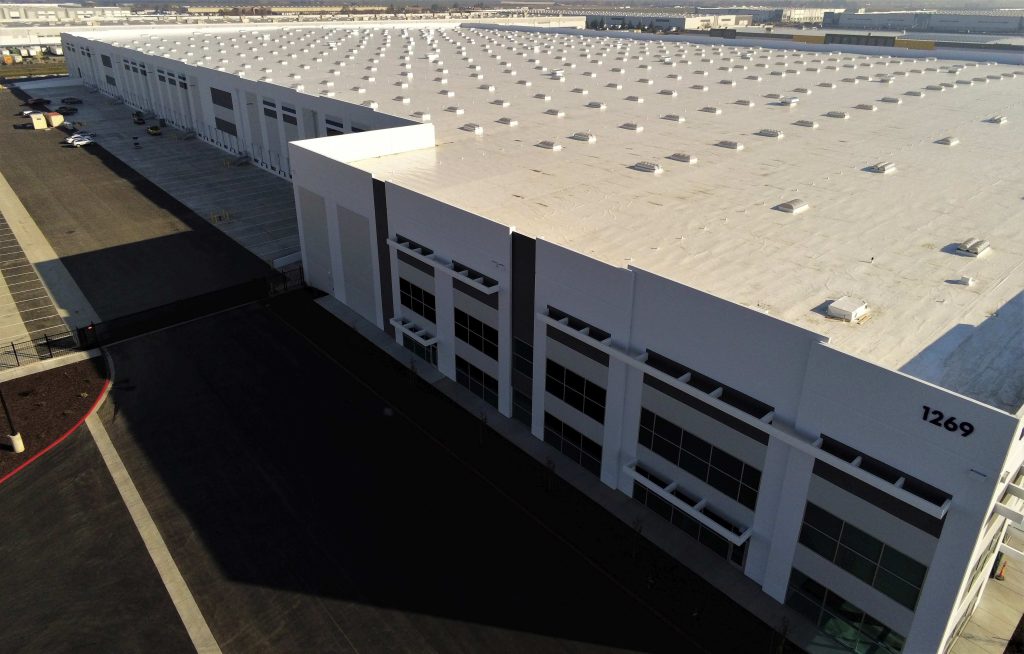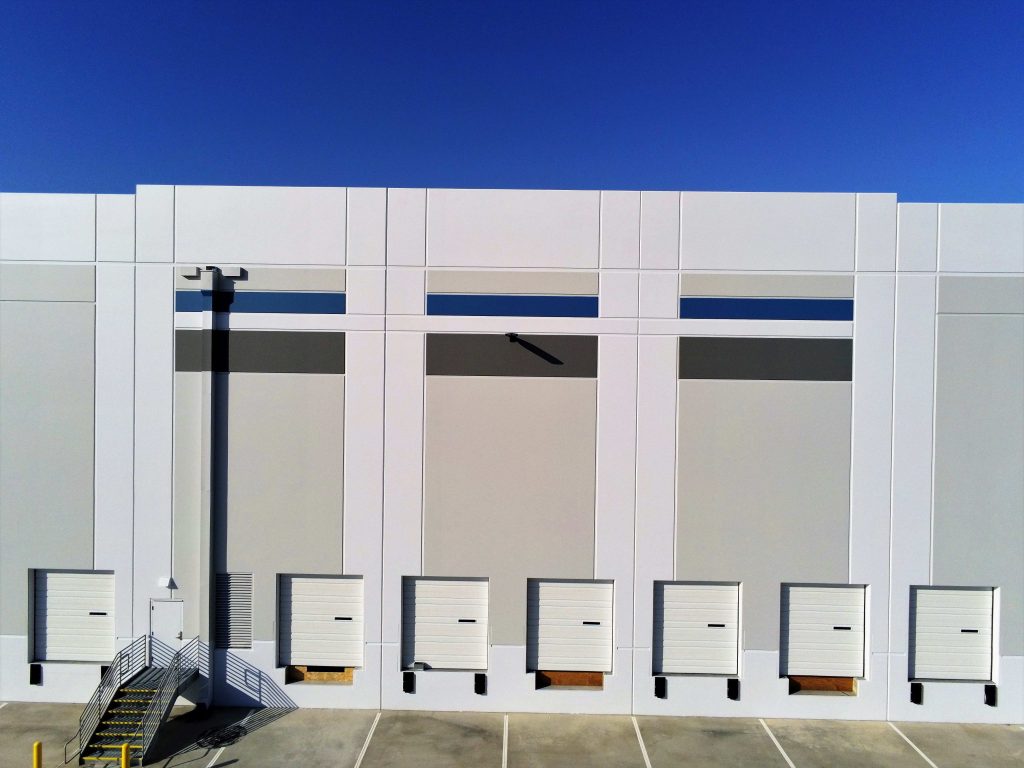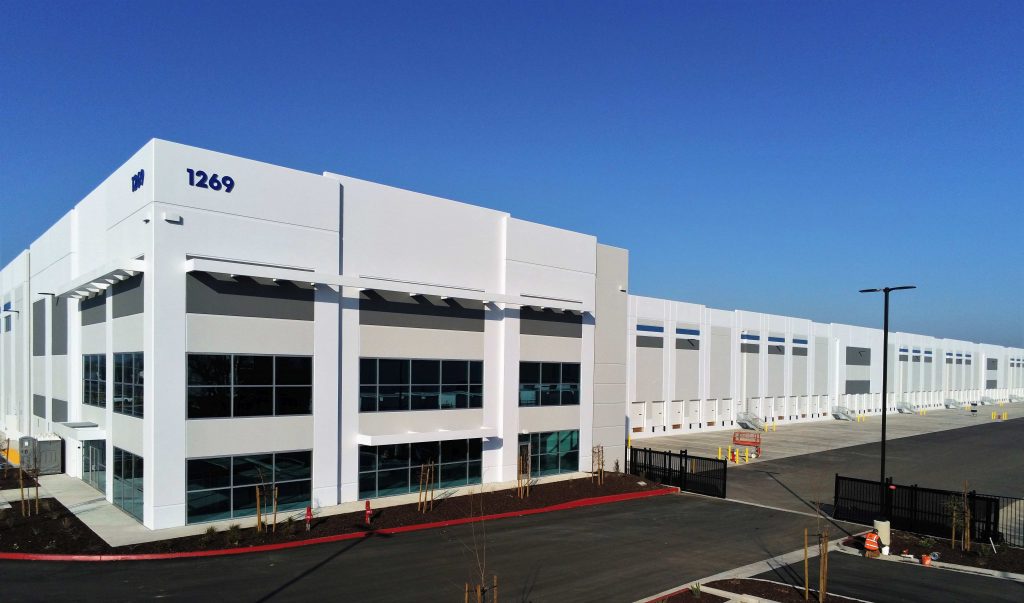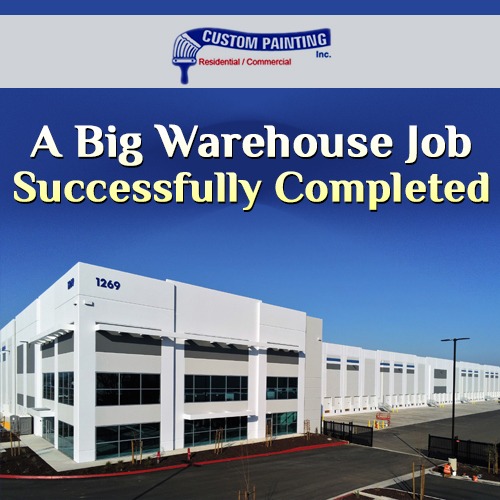In over 40 years in the industry, Custom Painting, Inc. has developed into a quality company providing residential and commercial painting services in the Bay Area. We take pride in our experience, skilled team of painters and carpenters, and unmatched customer service.
Whether we do house painting in Concord, commercial painting in Pleasanton, or elsewhere in the Bay Area, we strive for perfection in every project, leaving our customers happy and satisfied with our work.
Custom Painting, Inc. painting experts recently completed a large warehouse project at IPT-4 Grantline in Tracy, CA. They excel at large commercial projects like this, and we are glad to have another satisfied customer.
The warehouse was around 600,000 square feet, and our crew had to paint both the interior and exterior of the building. We estimate that we used 3,000 gallons of paint for the project, which took roughly three months to complete. We also had to use elastomeric paint to ensure we attained the necessary waterproofing.
Unique aspects and challenges during the project
Every project we have handled has a unique set of challenges, and this project at IPT-4 Grantline Tracy Warehouse is no exception. While it went smoothly most of the time, we did have some issues. Here are a few aspects and challenges we encountered during this painting project:
1) Painting the warehouse’s interior – The warehouse had significantly high walls. The lower portion of the wall, which measured 10 feet tall, needed more prep work before we could finish painting.
After we completed the prep work, we painted the upper portion of the walls and had to come back to paint the lower portion.
Since we could not paint from the ceiling down to the floor, there was a visible transition line between the upper and lower sections. So, we had to apply an extra coat of paint to even out the transition, make the final coat of paint appear more uniform, and achieve a seamless finish.
2) Waterproofing – The project required us to use elastomeric (waterproofing) paint. We chose Sherwin Williams Sherlastic elastomeric coating. Our crew had to make sure that they were applying the coating according to the manufacturer’s recommendations and that we reached the total recommended mil thickness for the paint to work as intended.
3) Safe painting process – We used wash-out barrels to avoid possible environmental impact. We sent these to a facility that handles hazardous wastes and materials. In addition, we used containment systems under the barrels to prevent accidental spills from reaching the ground.
4) Environmental and health concerns – Like any other responsible painting service company, Custom Painting, Inc. is always mindful of the impact paints can have on health and the environment.

Regarding specific steps we followed or products we used to help customers and staff sensitive to paint fumes, we know that painting an occupied building can be challenging. Most businesses and facilities remain open while the painting project takes place. So, in this project, we took steps to ensure that the warehouse staff, visitors, and our paint crew remained safe while the team was still painting the facility.
As paint experts, we know that traditional paints contain volatile organic compounds (VOCs), such as xylene, benzene, and toluene. Exposure to such VOCs may have the following side effects, such as:
- Dizziness
- Headaches
- Nausea
- Breathing difficulties
- Irritation of the eyes, nose, or throat
- It could also trigger allergic reactions, particularly asthma
- Long-term exposure could lead to severe ailments, such as certain cancers
Paints with low VOCs or zero VOCs are recommended for indoor painting. Fortunately, elastomeric paints have low VOCs, emitting fewer harmful fumes into the air. The elastomeric paints we used are safe for both indoor and outdoor painting.
Dealing with hazardous materials
As noted earlier, we used wash-out barrels for the project. The wash-out barrels are 55-gallon metal barrels with sealable lids. They allow us to clean out our pumps, rollers, and brushes. These barrels were then picked up and processed at Invert Environmental Consultants, a facility that deals with hazardous materials. Our commercial paint projects use containment systems under the barrels to ensure no accidental spills reach the ground.
Laws about the proper handling of hazardous materials in California
The California Health and Safety Code defines hazardous material as “a substance or waste that, because of its physical, chemical, or other characteristics, may pose a risk of endangering human health or safety or of degrading the environment.” The code implies that flammable, combustible, corrosive, reactive, radioactive, or toxic substances are considered hazardous.

The definition of “hazardous material” in this code is pretty broad. If a material or substance is considered harmful under any other safety, environmental, or transportation law or regulation, it is likely viewed as “hazardous material” in this code. These include:
- Substances requiring a Material Safety Data Sheet under worker protection laws
- Substances regulated as hazardous under transportation laws
- Substances listed as radioactive under federal environmental regulations
Some of the most common hazardous materials:
- Oils
- Fuels
- Cleaning solvents
- Paints
- Thinners
- Compressed gases
- Radioactive materials
Requirements – The Certified Unified Program Agency (CUPA) is an agency certified by the Secretary of the California Environmental Protection Agency (CallEPA). It regulates facilities that generate hazardous wastes or store hazardous materials.
Hazardous material or waste management facilities are required to obtain permits from CUPA to handle underground storage tank construction, removal, modification, and operation.
When proposing a new facility or modifying an existing one, it is a good idea to contact the following agencies:
- Certified Unified Program Agency (CUPA),
- Fire department (which has jurisdiction over the fire code implementation),
- Air pollution control district,
- Local community service agencies, and
- Local planning and building authorities.
They may have additional permits or other requirements as soon as possible in the planning process.
Elastomeric paints
Elastomeric paint is a high-build coating that protects masonry surfaces, such as brick and building stones (marble, granite, concrete, limestone, cast, glass, and adobe). It can be used on metal, wood, and vinyl – virtually every surface type.
Elastomeric paints have various uses but are typically used in commercial and industrial applications. Like many other paints, elastomeric paints are applied in liquid form, which then hardens and forms a durable but flexible and water-tight coating if applied correctly.
Here are the benefits of elastomeric paint:
- Water-tight – The coating creates a barrier, so moisture will not penetrate the walls.
- Long-lasting – Due to its strong composition, elastomeric paint is more durable and long-lasting than other paints.
- Flexible – As the name implies, elastomeric paint is made of flexible material. Thus, it can stretch and return to its original form without causing damage to the surface.
- Dense – Again, elastomeric paint is a high-build coating that is dense and heavy. It is ten times thicker than regular paint, creating a strong layer that can effectively protect any surface where it is applied.
- Energy-efficient – Elastomeric paint is heat-resistant and helps improve the energy efficiency of any building to which it is applied. Since it is resistant to ultraviolet rays, elastomeric paint acts as the building’s round-the-clock “sunblock.” Now, you know why this paint is highly favored, especially among commercial buildings and industrial facilities.
- Protective – Strong wind-driven rains can batter coatings over time, but not with elastomeric paint. It is made to withstand theserains and storms far better than your regular paint.

Elastomeric paint’s thickness
While elastomeric paint can be applied the same way as conventional paints, it is not a job for a novice or do-it-yourself painter. The paint’s density can be challenging to apply, especially if you have not been trained to handle this kind of paint.
When you’re used to regular paint, you might be surprised that elastomeric paint is quite dense and heavy. You will also notice the difference once it dries on the surface. It’s because elastomeric paint has more mils than traditional paint.
If you’re unfamiliar with the term “mil,” it refers to a unit of measurement used to determine the thickness of paint. A mil equals a thousandth of an inch (1/1000th, 0.001”, or 1.0 mil).
Elastomeric paint’s thickness varies, usually 10 to 20 mils per coat. On the other hand, regular paint will only have 3 mils per coat. Elastomeric paint’s thickness creates a strong and durable coating that can effectively protect the material it is applied to from the various weather elements.
The above reasons are why we chose Sherwin Williams Sherlastic coating for our recent project and many others.
Conclusion
Despite the challenges we encountered along the way – from painting the high interior walls to taking steps to prevent possible environmental impact during painting – our recent commercial project at IPT-4 Grantline warehouse in Tracy, CA, turned out successful. We were glad to add another satisfied customer.
When the customer is happy with our work, we consider it “mission accomplished.”
Are you opening a new business or planning to repaint your commercial property? Invest in a quality paint job with Custom Painting, Inc. We are a licensed, bonded, and insured residential and commercial painting company working across the Bay Area. Contact our office at 510-795-0903 to schedule a time for our estimator to visit your commercial building or facility and discuss your painting needs.

